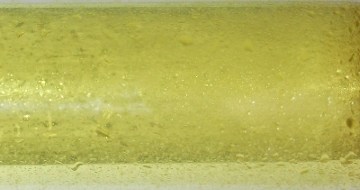
Chlorine
Chlorine General
| Name:Chlorine | Symbol:Cl |
| Type:Halogen | Atomic weight:35.453 |
| Density @ 293 K:0.003214 g/cm3 | Atomic volume:22.7 cm3/mol |
|
Discovered:
Chlorine was produced first in 1774 by Carl Wilhelm Scheele, who collected the gas released by the reaction of pyrolusite (manganese dioxide) with the substance we now call hydrochloric acid. It had, according to Scheele, "a very perceptible suffocating smell, which was most oppressive to the lungs... and gives the water a slightly acidic taste... the air in it acquires a yellow color..." Scheele also noted the reactivity and bleaching qualities of the new gas he had made: "all metals were attacked... fixed alkali was converted into common salt... all vegetable flowers - red, blue, and yellow - became white in a short time; the same thing also happened with green plants... insects immediately died. (1) |
|
Chlorine States
| State (s, l, g):gas | |
| Melting point:172 K (-101 °C) | Boiling point:239 K (-34 °C) |
Chlorine Energies
| Specific heat capacity: 0.48 J g-1 K-1 | Heat of atomization:122 kJ mol-1 |
| Heat of fusion:6.406 kJ mol-1 of Cl2 | Heat of vaporization :20.41 kJ mol-1 of Cl2 |
| 1st ionization energy:1251.1 kJ mol-1 | 2nd ionization energy:2297.3 kJ mol-1 |
| 3rd ionization energy:3821.8 kJ mol-1 | Electron affinity:349 kJ mol-1 |
Chlorine Oxidation & Electrons
| Shells:2,8,7 | Electron configuration: [Ne] 3s2 3p5 |
| Minimum oxidation number:-1 | Maximum oxidation number:7 |
| Min. common oxidation no.:-1 | Max. common oxidation no.:7 |
| Electronegativity (Pauling Scale):3.16 | Polarizability volume:2.2 Å3 |
Chlorine Appearance & Characteristics
| Structure:layers of Cl2 | Color:greenish-yellow |
| Hardness:mohs | |
|
Harmful effects:
Chlorine is a toxic gas that irritates the skin, the eyes and the respiratory system. |
|
|
Characteristics:
Chlorine is a greenish-yellow, diatomic, dense gas with a sharp smell (the smell of bleach). Uses: Chlorine is used for producing safe drinking water. |
|
Chlorine Reactions
| Reaction with air: none | Reaction with 6 M HCl:mild, ⇒ HOCl, Cl- |
| Reaction with 15 M HNO3: mild, ⇒ HClOx, NOxCl, NOx | Reaction with 6 M NaOH:mild, ⇒ OCl-, Cl- |
Chlorine Compounds
| Oxide(s):Cl2O, ClO2, Cl2O7 | Chloride(s):Cl2 |
| Hydride(s):HCl |
Chlorine Radius
| Atomic radius:100 pm | Ionic radius (1+ ion):pm |
| Ionic radius (2+ ion):pm | Ionic radius (3+ ion):pm |
| Ionic radius (2- ion):pm | Ionic radius (1- ion):167 pm |
Chlorine Conductivity
| Thermal conductivity:0.0089 W m-1K-1 | Electrical conductivity:S cm-1 |
Chlorine Abundance & Isotopes
| Abundance earth's crust:145 parts per million by weight, 85 parts per million by moles | |
| Abundance solar system:8 parts per million by weight, 0.3 parts per million by moles | |
| Cost, pure:$0.15 per 100g | |
| Cost, bulk: $ per 100g | |
|
Source:
Chlorine gas is produced commercially by the electrolysis of sodium chloride (NaCl) from seawater or brine from salt mines. |
|
|
Isotopes:
Chlorine has 16 isotopes whose half-lives are known, with mass numbers 31 to 46. Of these, two are stable: 35Cl and 37Cl. |
|
Chlorine Other
|
Other:
References |
|
Prev: Sulfur Next: Argon |